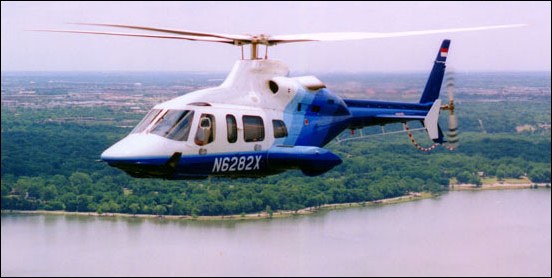
| Bell Model 430 1997 |  |
 |

| Bell Model 430 1997 |  |
 |
|
Model 230 with four-blade '680' bearingless main rotor, 0.45m longer cabin, redesigned glass cockpit. Powered by two 808shp Allison 250-C40 turboshafts. Prot. C-GBLL FF 25 Oct. 1994. R.Simpson "Airlife's Helicopter and Rotorcraft", 1998
Preliminary design 1991; four-blade rotor, higher-powered and stretched variant of Bell 230; programme launched February 1992; two prototypes, modified from Bell 230 airframes: first prototype (C-GBLL; wheel-equipped) flown 25 October 1994; second prototype (C-GEXP; skid-equipped, with complete avionics suite) flown 19 December 1994; first flight of production 430 (C-GRND) in 1995; deliveries began 25 June 1996 after Canadian type approval on 23 February. Single-pilot IFR and Category A certification anticipated early 1999. MoU of June 1996 with Dirgantara (formerly IPTN) for licensed assembly and marketing in Indonesia. Second production aircraft, N4300 circumnavigated the world in a record time of 17 days 6 hours 14 minutes, landing back at Fairoaks, UK, on 3 September 1996. Neiman Marcus Special Edition introduced in 2001 for Neiman Marcus store's 75th Christmas catalogue, featuring three-colour custom metallic exterior paint scheme with NM signature. Italian leather and rosewood interior, sculpted carpets with NM logo, passenger refreshment centre, Blaupunkt AM/FM/CD entertainment centre. JetMap cabin information system with moving map displays on two ceiling-mounied monitors. Motorola cellphone and two computer ports. CUSTOMERS: First delivery 25 June 1996, when sixth production aircraft (N6282X) handed over to IPTN (now Dirgantara) of Indonesia in eight-seat executive configuration. Thirteen delivered in 1996; followed by eight, 15 and 18 in 1997-99, 11 in 2000, 14 in 2001 and seven in 2002. Recent customers include STAT MedEvac of Pittsburgh, which took delivery of an EMS-equipped Bell 430 (N430Q) in January 2002. COSTS: Programme US$18 million, 35% financed by Canadian Defence Industry Productivity Program (DIPP) and repayable as royalty on each sale. DESIGN FEATURES: Optimised for high cruising speed with (retractable) wheel landing gear, although traditional skids optional; inclined towards executive transport market. Bell 230 fuselage lengthened by 0.46m plug; Bell 680 all-composites four-blade bearingless, hingeless main rotor; approximately 10% power increase over Bell 230; uprated transmission; and optional EFIS. Short-span sponson each side of fuselage houses mainwheel units and fuel tanks, and serves as work platform. FLYING CONTROLS: Fully powered hydraulic, with elastomeric pitch change and flapping bearings; fixed tailplane with leading-edge slats and endplate fins; strakes under sponsons; single-pilot IFR system without auto-stabilisation. STRUCTURE: Semi-monocoque fuselage of light alloy, with limited use of light alloy honeycomb panels. Fail-safe structure in critical areas. One-piece nosecone tilts forward and down for access to avionics and equipment bay. Short span cantilever sponson set low on each side of fuselage, serving as main landing gear housings, fuel tanks and work platforms. Section NACA 0035. Dihedral 3° 12'. Incidence 5°. Sweepback at quarter-chord 3° 30'. Fixed vertical fin in sweptback upper and lower sections. Tailplane, with slotted leading-edge and endplate fins, mounted midway along rear fuselage. Small skid below ventral fin for protection in tail-down landing. Four-blade main rotor with stainless steel spars and leading-edges. Nomex honeycomb trailing-edge with glass fibre skin, and glass fibre safety straps; tail rotor blades stainless steel. Rotors shaft-driven through gearbox with rwo spiral bevel reductions and one planetary reduction. Main blade and hub life, 10.000 hours. LANDING GEAR: Tubular skid type on Utility version. Executive version has hydraulically retractable tricycle gear, single mainwheels retracting forward into sponsons; forward-retracting nosewheel fully castoring and self-centring; hydraulic disc brakes on main units. Mainwheel tyre size 18x5.5, nosewheel 5.00-5. Emergency floats optional. POWER PLANT: Two Rolls-Royce 250-C40B turboshafts, each rated at 603kW for T-O and 518kW maximum continuous. OEI ratings 701kW for 30 seconds, 656kW for 2 minutes, 623kW for 30 minutes and 602kW continuous. Chandler Evans FADEC. Transmission rating 779kW for 5 minutes for T-O, 737kW maximum continuous. Power train TBO, 5,000 hours. Usable fuel capacity 935 litres in skid version, 710 litres in wheeled version; provision in both versions for 182 litre auxiliary tank. Fuel system is rupture resistant, with self-sealing breakaway fittings. ACCOMODATION: Standard layout has forward-facing seats for nine persons (two-two-two-three) including pilot. Options include 10-seat layout (two-two-three-three); eight-scat executive (rear six in club layout), six-seat executive (rear four in club layout with console between each pair); and five- and four-seat executive with one or two refreshment cabinets; seat pitches vary between 86cm and 91cm. Pilots on crashworthy (energy attenuating) seats, which are optional for passengers. Customised emergency medical service (EMS) versions also available, configured for pilot-only operation plus one or two pivotable stretchers and four or three medical attendants/sitting casualties respectively. Two forward-opening doors each side; EMS version has optional stretcher door between forward and rear doors on port side. Entire interior ram air ventilated and soundproofed. Dual controls optional. SYSTEMS: Dual hydraulic systems (dual for main rotor collective and cyclic, single for tail rotor). Dual 28V DC electrical systems, powered by two 30V 200A engine-mounted starter/generators (derated to 180A) and a 24V 28Ah Ni/Cd battery.
AVIONICS: Comms: Bendix/King Gold Crown III. EQUIPMENT: Standard equipment includes rotor and cargo tiedowns, ground handling wheels for skid version, retractable 450W search/landing light. Options include dual controls, auxiliary fuel tankage, force/feel trim system, more comprehensive nav/com avionics, 272kg capacity rescue hoist, 1587kg capacity cargo hook, emergency flotation gear, heated windscreen, particle separator and snow baffles. Jane's Helicopter Markets and Systems
|